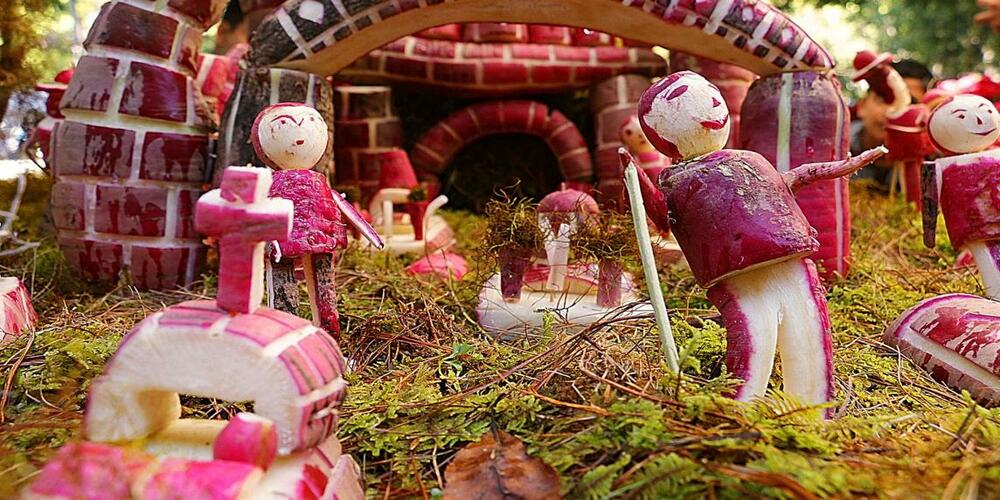December 23rd is Noche de los Rabanos in Oaxaca City (Night of the Radishes), a Christmastime festival that has no match in oddity and creativity anywhere else in Mexico. Wild animals, the Virgin of Guadalupe, mythical creatures and scenes of everyday Oaxacan life are all represented in shades of magenta and cream in the form of local radishes grown solely for the occasion—it’s a comical, whimsical and edible time.
The tradition of holding a yearly radish carving competition dates back to 1897 when Oaxaca City’s mayor, Francisco Vasconcelos, decided to make the contest part of that year’s Christmas market, which sold traditional flowers, herbs and ingredients for holiday dishes as well as decorations for the home. Because radishes had always been integral to Oaxaca’s Christmas cuisine as both an essential ingredient and a decorative garnish, the radish contest was seen as a fun way to promote local agriculture.
One story suggests that the first radishes used for the festival were left too long in the soil at the end of the growing season and became misshapen, almost human-like, which is when local artists came up with the idea of carving them. Whether that’s true or not, what’s certain is that the festival’s first contestants created more natural shapes from the radishes they were given, making just a few cuts and changes to them. You can see an example of what these early radishes might have looked like in Diego Rivera’s Las Tentaciones de San Antonio.
Those first simple carvings have since evolved into intricate and skilled designs created by master carvers who work with the help of their families. Entire nativity scenes and elaborately detailed everyday items are carved from the radishes’ splendid tones of white and pink, creating lively scenes from lowly roots. A true artist’s eye is necessary in order to win the contest.
While much planning is involved leading up to the contest, the entire event takes place in the span of just a few hours—once the radishes start to wilt and turn brown, their allure is over. Families and groups of carvers start working together from the morning of the event to have their scenes ready for display by 5 pm. Tourists and guests are then invited to walk among the sculptures for a few hours and prizes are awarded later in the evening.
When the tradition of the festival started, the radishes to be used in the competition were grown along the Río Atoyac. The land was slowly eaten up over the years by the expanding capital city and the local government eventually had to set aside an area of land that would only be used for cultivating the festival radishes. A large, white radish called criollo was once used in the competitions but can no longer be found in the Oaxacan countryside. Today’s sculptures and figurines are made from the more common radishes found in any local market that have a white flesh and pink exterior.
The radish sculptures can take on any form, but many carvers pay homage to the season and local religious traditions by creating scenes from the Bible and other similarly-themed images, while other artists choose to re-create scenes from everyday life. Different categories exist to judge the different styles of artwork in order to hold a balanced competition: a traditional category for religious art is complemented by a “free” category that has less restrictions to allow for more contemporary themes. There’s even a category for radishes carved by the city’s children, who will become the next radish-carving generation.
Though Oaxaca has a long, proud tradition of artisanal wood-working, papier-mâché sculptures and many other local arts and crafts, the Night of the Radishes is a unique extension of the incredible talent that the state of Oaxaca brings to the rest of the country.
By: T. Polo
Source:
https://theculturetrip.com/north-america/mexico/articles/a-uniquely-oaxacan-
festival-night-of-the-radishes/

